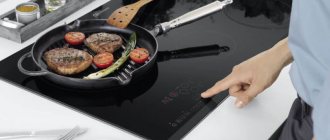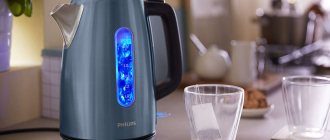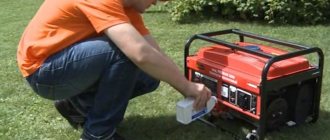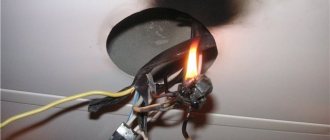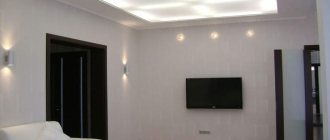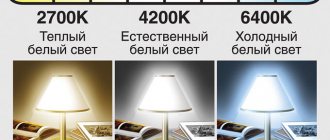Connecting equipment
Installation diagram of an electric floor oven.
The sauna stove is practically made with your own hands. All that remains is to connect it and check its functionality
It is very important to correctly calculate the power of the stove and select a power cable for it. The power of the stove is quite large, so the cable must be selected with a small margin
And the thickness of the core must be appropriate, the insulation must be reliable. The connection is made through a thermostat. If you mainly enjoy dry steam, the regulator can be installed directly in the steam room. But it is much safer to place this element in the dressing room. Then the version of the Russian bath will be safe for visitors to the steam room.
Don't forget to ground the heater body
It is important!. Now the basket needs to be filled tightly with stones
It should be remembered that the larger the total area of contact between the stones, the higher the heat transfer will be. It is advisable to use stones of flat shape and different sizes for the stove. Then you will have the opportunity to pack them in the basket as tightly as possible. Try to maximize the height of the stones, since the volume is also very important: the larger it is, the longer the high temperature will remain in the steam room
Now the basket needs to be filled tightly with stones. It should be remembered that the larger the total area of contact between the stones, the higher the heat transfer will be. It is advisable to use stones of flat shape and different sizes for the stove. Then you will have the opportunity to pack them in the basket as tightly as possible. Try to maximize the height of the stones, since the volume is also very important: the larger it is, the longer the high temperature will remain in the steam room.
Connecting lamps and sockets
In the bathhouse, the most dangerous room is the steam room, which is divided into 4 zones:
- Zone 1 contains only a stove, including an electric or electric heater;
- In zone 2, placed electrical equipment, to which heat resistance requirements do not apply;
- In zone 3, the devices used must withstand temperatures above 125 degrees, and the insulation of wires and cables must be at least 170 degrees:
- In zone 4, only temperature sensors are connected, for example, for controlling electric furnaces, triggered at 140 degrees and with wire insulation, as in zone 3.
It is generally prohibited to lay any electrical wires above the stove, and to place electrical equipment and devices within a radius of half a meter from it.
Lamps in the steam room and in the washing room must be sealed, which, including LED strips, can only be installed on the walls of the steam room no higher than the third zone.
It is recommended to place switches at a height of up to 1 m from the side of the door handle or under the ceiling with control via a cord and outside the steam room or washing compartment.
In accordance with the provisions of the governing documents and standards, the switches are located so that when the lower part of the control key is pressed, the light is turned off.
With the open method of internal wiring, insulators, a plastic cable duct or a corrugated hose are used, and to illuminate the rest room and dressing room, it is appropriate to use LED lamps, since they consume little power.
Electrical installation of sockets in the bathhouse is carried out at a height of more than half a meter from the floor and no closer than 60 cm from water sources, but in the steam room and in the washing room the installation of plug sockets is excluded.
In other rooms of the bathhouse, if the electrical wiring is hidden, plastic corrugation and socket boxes should be used to remove the wires, and it is recommended to route cables and wires through the attic.
Do-it-yourself electrical wiring in the bathhouse should be done strictly horizontally and vertically, not allowing the cables to deviate at an angle, which applies to the mostly hidden wiring method, but the horizontal sections should be located 20 cm from the ceiling.
Distribution boxes are also mounted at the same level, and contact in them between wires of the same color is ensured by special connectors, but it is better when solder connections are used.
The protective plastic corrugated sleeve of the wires should extend into the junction box by 2.5-3 cm, for which the rubber seals are trimmed or removed from the side holes, but special attention is paid to the rubber sealing ring under the lid, which protects the inside of the box from moisture penetration. If there is an urgent need to place the connection in water, then the area after soldering should be treated with hot-melt adhesive and placed in a heat-shrinkable tube
If there is an urgent need to place the connection in water, then the area after soldering should be treated with hot-melt adhesive and placed in a heat-shrinkable tube.
Finally, it is extremely important to carry out electrical installation work only when the electricity is turned off, hanging a sign on the distribution panel with the inscription:
and apply voltage for short periods of time only for control.
After completing all installation work, it is a good idea to contact the nearest electrical laboratory at the location of your country property to conduct acceptance tests.
Mandatory and optional components of an electric sauna stove
After the article mentioned heating elements more than once, it’s time to clarify what they are, which ones are better, and what else is included with electric stoves.
Heating elements for electric heaters
A heating element is a tubular electric heater; it is found not only in heaters, but also in washing machines and kettles. This is a spiral in a durable shell - a tube, usually made of stainless metal.
Heating elements are relatively cheap, but at the same time they are very fragile, especially when they are in the open state, as in heaters. When laying stones, they can be damaged. Filling them with water can ruin them. And yet most manufacturers still include them in their products.
However they have an alternative:
Electric heaters with band heaters
Tape heaters have two advantages: they are stronger and more economical than their predecessors. Cost-effectiveness is expressed in the fact that, with equal power to heating elements, tape heaters heat 1.5 times more volume, and strength lies in the fact that it is much more difficult to damage them, because the heaters are located inside the ceramic tape.
Electric heater with tape heaters. Photo source
The cost of electric heaters with tape heaters may be higher, but they are still somewhere in the middle price category; there are heaters with heating elements that are much more expensive.
Electric heater control panel
There are often models on sale with two modifications: built-in and remote control panels. In the first case, all buttons and knobs will be located on the body, in the second - on a separate remote control.
Electric heater control panel
Standard features include temperature control, the ability to delay start up to 9 hours, and the ability to automatically turn off after a set period of time. If the heater has a steam generator, then there is humidity control.
More remote controls for electric heaters
Electric sauna stove with water tank
Sometimes Internet users search online for an electric furnace with a water tank. Here we will disappoint them. When it comes to a water tank in a bathhouse, it usually means that there is no connection to a hot water supply, so you have to heat the water yourself for the needs of the washing room (we have detailed information about such stoves). However, this does not work for electric sauna stoves: yes, they also come with water tanks, but we are talking about models with steam generators that need this water to create steam. We simply didn’t find any other options!
Varieties
Electric stoves can be roughly divided into those intended for saunas and those used for Russian baths. A mandatory element of the latter is a steam generator. Its presence in sauna devices is at the discretion of the buyer.
Devices with a steam generator usually have a water tank. Water is poured into them manually or supplied automatically if the structure is connected to a water supply system. The heating temperature reaches 600 C.
Some models are equipped with compartments for medicinal plants or essential oils. It should be understood that this tank is designed for the operation of a steam generator. It cannot be used for washing and domestic needs in the absence of hot water supply. Firstly, compared to tanks in a stone sauna stove, for example, this tank has a small volume. Secondly, it does not provide a tap or wide lid for drawing heated water.
Electric stoves, like any sauna stove, come with an open and closed heater. The latter are also called “thermoses”. A stove with an open heater, according to users, allows you to create the mood of a classic Russian steam room. The heating stones in such a device are visible and can be watered with water. Thanks to the high temperature, it instantly evaporates, turning into transparent vapor.
However, stones in an open system cool quickly, requiring additional electricity consumption to heat them. The stones in the “thermos” are constantly in heating mode. They do not cool down, so as the desired temperature in the steam room is reached, they can be switched to heat maintenance mode, thereby reducing energy consumption. Closed heaters are expensive. Their price on average starts from 50,000 – 70,000 rubles, while the minimum cost of an open analogue is 10,000 – 14,000 rubles.
The difference between the units is also due to the type of heating elements used. The following varieties are distinguished:
Tubular (heating elements). It is a heated spiral enclosed in stainless steel tubes. Heating elements are used in many household appliances, for example, a washing machine. The advantage is low cost. However, the device is not very durable. When laying stone they are easily damaged.
Depending on the location of the control panel, there are devices in which the control system is located outside the steam room, as well as those in which the control buttons are located directly on the device body.
The former are preferable because they are protected from the adverse effects of moisture. They are safe and durable. Models with a control panel on the oven body may be damaged by accidental water ingress.
A separate panel can be mounted in any convenient place; it is recommended to take it outside the steam room, for example, to a dressing room or relaxation room. For ease of use, such devices are available with a remote control. In other words, all the necessary parameters are set before starting the bath procedures on the control panel; if you need to make changes to them, there is no need to leave the steam room, just use the remote control.
There are wall and floor models. The former are equipped with brackets for fastening, the latter have legs. There are universal designs that can be mounted in any of these ways. A type of floor-standing electric heaters are corner devices, which are optimal for small steam rooms.
Depending on the shape of the device, there are cylindrical, rectangular, and round. They have different dimensions and designs. There are both laconic rectangular and corner designs, as well as stoves that imitate a fireplace or traditional, supercharged ones (wood-burning, for example), equipped with a mill wheel through which water flows.
The dimensions of the furnace are determined by its power and the number of stones loaded. Thus, small structures, designed primarily for saunas, can hold up to 35–40 kg of stones. For a Russian steam room, it is better to choose a device with a maximum load of 60–120 kg. It gives good heat, you can pour large volumes of water on the stones. Most of these models have 2 operating programs - in “sauna” and “bath” mode.
The outer casing of the device is designed to protect heating and other elements from damage, as well as to protect the user from burns. It can be made of metal, upholstered in heat-resistant wood, or soapstone (a natural mineral). Models with an open heater surrounded by a mesh body look no less impressive.
How to correctly calculate the power of an electric furnace
Despite the fact that home craftsmen often take 1 kW per 1 m³ of volume as a rule, small adjustments should be made. For example, tile, glass or stone as a finishing material requires separate calculations. Here the quadrature is calculated, which is added to the volume. A door made of glass will also “steal” one and a half cubic meters. Let's try to calculate the average power required for a bathroom with dimensions of 2.5 × 2 × 1.8 m, stone trim on one of the walls, dimensions 2 × 1 × 1.8 m and a glass door. We get 9+3.6+1.5=14.1 kW. It is precisely from the power of 14 kW that it is worth “dancing”.
Such a glass door will “take away” almost one and a half kilowatts of power
Power selection and installation
First, calculate the volume of the existing steam room and select the required number of heating elements.
Sauna heater from a washing machine.
For a wooden bath you will need to achieve a power of 1 kW per 1 m² of space. For a brick building, it will be enough to have a power of 0.8 kW for the same volume. As a rule, it is convenient for users to connect all electrical systems to a 220V network. In this case, all heating elements must be connected in parallel.
But first you need to prepare a sheet metal case, inside of which all the heating elements will be located.
There is no fundamental difference in the location of the heating elements: they can be placed either vertically along the walls or horizontally in the lower part of the body.
The latter option should be considered more preferable, since in this case the stove will operate with the highest possible efficiency. Convection and high thermal conductivity of the stone will contribute to this.
Heating elements should be mounted on a metal body very carefully, using asbestos sheets as a gasket between the heating elements and the metal. This material has a minimal heat transfer coefficient, so the housing will not heat up directly from the heating elements.
But it will have to be protected from infrared radiation. For this you will need a heat insulator with a reflective surface.
Electrical diagram of a heater with heating elements.
Above the heating elements, it is necessary to weld a metal grid made of thick wire or fittings. The grate must be strong, since a large mass of stones will be placed on it.
It is recommended to make the upper part of the heater as open as possible. This means that the stones must be kept from falling off the heater by a minimum amount of metal.
Try welding a kind of basket for stones from the same reinforcement. It won't look very good, but it can be decorated with elements that imitate forging. Such things will give the steam room a special charm, and you will be pleased to watch the creation of your hands.
Forged elements can be different: leaves, flowers, various kinds of curls
What is important here is not their quantity, but their skillful combination. Create a pattern that will be pleasing to your eye and weld all the elements of the resulting structure
Additional recommendations for the master
But here all calculations must be made especially carefully in order to avoid excessive heating of the heating elements and their premature failure. Care must be taken when installing heating elements into a single electrical circuit. You definitely can’t do without some knowledge of electromechanics and electrical engineering. And if you don’t have such knowledge, then seek help from an experienced master.
Sometimes combined types of heaters are used in the interior of steam rooms. In addition to the electric stove, users install a brick wall finished with natural stone. This will increase heat transfer slightly, but additional safety measures will be required. You will need to lay a layer of thermal insulation between the load-bearing and imitation wall
This is important if the bathhouse is built using a large number of wooden elements (log house). For brick baths, there is no need for additional walls, since they only increase the percentage of heat losses
Electric sauna stoves for 220 and 380 volts: is there a choice?
Above, we divided the stoves into three categories: strictly 220, strictly 380 and “border guards”, which can be connected to any network. And from what was said earlier, you already understand that such division is derived from the power of the furnaces, which generates the current strength that your wiring will either withstand or cannot withstand.
Therefore, it will not be superfluous to consult with an electrician who will tell you about the possibilities of connecting a specific stove to your specific wiring.
However, the determining factor when choosing a stove should still be the volume of the heated room - it determines how powerful the electric heater will be. Next, you will find out from the sellers what the voltage of the stoves of the required power is. And if the oven ends up in the 220/380 range, then it’s up to the electrician to determine the wiring options.
We admit that the reader may have another situation: a house with a future sauna is at the design or construction stage, and the question of which network to install - single- or three-phase - is being decided.
ATTENTION! Based on personal experience, we definitely recommend three-phase wiring.
This will slightly increase your costs for machines and wires. But in the end you get a choice between 220 and 380 V. There are a number of conveniences associated with a three-phase network, but the article is not devoted to this topic, alas!
Dimensions
The smaller the sauna, the more important the size of the stove becomes. Low-power heaters are usually very modest in size. As an example, we can mention the Harvia Compact stove - its width is 24.5-30 cm, depth 22 cm, height 54 cm. It weighs only 9 kg (without stones). Another model from the same company - Vega Compact - weighs even less: 7 kg and has dimensions: 28x29.5x50.5 cm.
IMPORTANT! Information on sizes is essential for selection, therefore it is always indicated in catalogs.
Yes, and one more interesting point : ovens of the same size (within the same line) can have different power. This allows the manufacturer to reduce production costs, and the consumer to choose a standard-sized heater for the volume of the steam room.
Further information will be useful to those who have already purchased a stove and need information on how to properly install and connect it.
Electric sauna stove: installation instructions
Installation of an electric oven is simple; instructions from the device manufacturer are always supplied with the purchased product. The specifics of the installation lie in the conditions in which the electrical appliance will operate. The temperature and humidity in the sauna create a risk of electric shock, so many factors must be taken into account when connecting the stove.
Choosing an electric stove for a bath
When purchasing an electric sauna stove, pay attention to the following points:
The power of the product is determined from the condition: 1 kW of furnace - per 1 m 3 of steam room. If there are poorly insulated areas (glass doors, windows, tiles), the power of the device must be increased. Each square meter of such areas increases the volume of the steam room for calculations by 1.5 m 3
Therefore, it is important to insulate the room well, first of all, the ceiling.
Wiring requirements for an electric furnace in a bathhouse
Electric sauna stoves 220 V with a power of up to 4.5 kW operate on single-phase current. High power devices use three-phase current. You can connect several heating elements in parallel to the network, but this increases the current threefold. Therefore, in this case, select the correct cross-section of electrical wires designed for the power of the furnace.
For a single-phase network, use a three-core cable, for a three-phase network, use a five-core cable.
Rules for placing an electric furnace for a bath
It is recommended to install an electric stove in the corner closest to the front door. Manufacturers produce corner electric stoves for Russian baths; some models can be hung on the wall. Modern products can be installed in the middle of a steam room if all requirements for the safe operation of the device are met.
- The gaps specified in the technical documentation of the device must remain between the hot surfaces of the stove and the walls of the bath. Typically the gaps are 50 cm.
Features of installing electric furnace elements in a bathhouse
Installation of the furnace body in the bathhouse
The housing contains heating elements and their connection points. There are models in which space is allocated for stones, a water tank or a steam generator.
Installation of a control panel for an electric furnace in a bathhouse
Using the remote control you can set the temperature and various effects. Sensors allow you to see changes in heating. In modern electric sauna stoves, the control panel of the device is often built into the stove body, and the device is configured directly from the steam room. A remote control is also supplied with the device and performs duplicate functions. When installing the remote control, adhere to the following recommendations:
Due to the high temperature and humidity in the steam room, install the remote control on the wall in a room that is maintained at room temperature.
Temperature and humidity sensors for an electric furnace in a bathhouse
The sensors are connected using special heat-resistant cables. Sensor wires must be solid; multiple cables connected to each other cannot be used for extension. They are installed in the places specified in the oven operating instructions. Typically, sensors are installed above the stove, shelves or above the exit from the steam room.
Grounding an electric furnace in a bathhouse
The room must have its own grounding circuit to which the stove is connected. The circuit is buried in the ground at the construction stage of the bathhouse. The grounding cable from the furnace to the circuit is pulled through cable channels. If there is no circuit, connect the oven grounding cable to the neutral terminal on the electrical panel.
This concludes the list of basic rules for installing an electrical device in a bathhouse. By completing them, you will be able to install an electric sauna stove with your own hands and get a safe, easy-to-use unit.
Operating rules
A do-it-yourself electric oven must be operated in a room with a reliable ventilation system.
The electrical wiring must be in good working order, its energy capabilities allow it to withstand the load from this electrical appliance, eliminating the risk of a short circuit. In addition, there are a number of rules that must be followed:
- Do not connect the device to the power supply system without sufficient water in the device.
- Before the first fire and periodically during operation, measure the resistance from the network, which should not exceed 3 - 5 ohms.
- To prevent damage to the heating elements due to scale, you need to fill the device with water softened with vinegar or citric acid.
- Once every six months, the stones are moved into the electric furnace and cleaned of dust and cracked elements.
- If in winter the bathhouse is not heated regularly, then after each visit to the bathhouse the water from the stove must be drained, since it can expand when freezing and break the connecting seams of the body.
Kinds
Electric stoves come in a wide variety and can be successfully used in almost any room. The classification of furnaces is given in the table:
| Classification | There are | Peculiarities |
| By accommodation type | wall-mounted | used in tight spaces, reduces the risk of burns |
| floor | for larger saunas | |
| By shape | cylindrical | the optimal choice depends on the design and dimensions of the room |
| rectangular | ||
| square | ||
| spherical | ||
| corner | ||
| Depending on power | with power supply from 220V | with power up to 7 kW |
| powered by 380V | with power over 7 kW | |
| By type of heater | open | quick heating of the room |
| closed | heat preservation | |
| According to case material | steel | last longer than others |
| aluminum | the lightest and most durable, but cools faster | |
| cast iron | hold heat better than others, have a lot of weight | |
| Additional options | with steam generator | capable of producing wet steam |
| without steam generator | If necessary, the steam room can be purchased separately |
Design features of electric heaters
An electric stove for baths and saunas is intended for heating rooms and organizing hot water supply. Structurally, the device consists of the following elements:
- double body;
- electric heaters;
- thermal insulation.
Heating elements are installed inside the body, and a cage for heating bath stones is mounted on top. The rate of heating of the room and the quality of the steam produced depend on the correct selection and placement of stones.
Large and heavy stones are able to maintain the optimal air heating temperature for a long time.
The outside of the case is equipped with metal plates (3.5 mm thick) to organize technological ventilation gaps, which contribute to the safe cooling of the device.
Metal screens are used as the main elements of heater insulation. They reliably protect wooden surfaces from fire and overheating.
An electric stove with a closed and open design can be installed in a private bathhouse. Still, open electric heaters are more in demand, which provide quick heating of the room and the production of clean steam.
Such devices are equipped with a nichrome wire thread, which is mounted in a stand and turns into a heating base.
Closed electric heaters are available in horizontal and vertical versions and are structurally composed of a heater, a heat shield and a current-conducting busbar.
Popular models
At 220V
Electric bath stove 220V is used for saunas if the required design power does not exceed 7 kW
Please note that most 220V models can also operate on 380V, if the need arises
SAWO SCANDIA SCA-60NS-Z
- Price - from 8,000 rubles
- Power, kW: 6
- Voltage: 220V / 380V
- Control: remote
- Heated volume, m3: 5-8
- Dimensions, mm: 410x290x450
- Weight of stones, kg: 22
- Case material: stainless steel
- Country of origin: Finland
Harvia Vega BC-45
- Price - from 13,600 rubles
- Power, kW: 4.5
- Voltage: 220V / 380V
- Control: on the body
- Heated volume, m3: 3-6
- Dimensions, mm: 480x310x540 mm
- Weight of stones, kg: 25
- Case material: stainless steel
- Country of origin: Finland
Tulikivi Huurre Black
- Price - from 79,900 rubles
- Power, kW: 6.8
- Voltage: 220V / 380V
- Control: remote
- Useful volume, m3: 5-9
- Dimensions, mm: 380x380x950 mm
- Weight of stones, kg: 60
- Case material: ceramic
- Country of origin: Finland
Tylo Sense Combi + Elite Remote Control
- Price - from 130,000 rubles
- Power, kW: 6.6
- Voltage: 220V / 380V
- Control: remote
- Heated volume, m3: 4-8
- Dimensions, mm: 480x310x540 mm
- Weight of stones, kg: 25
- Case material: stainless steel
- Country of origin: Sweden
Harvia Cilindro PC-70 F
- Price - from 28,000 rubles
- Power, kW: 6.8
- Voltage: 220V / 380V
- Control: remote
- Heated volume, m3: 6
- Dimensions, mm: 320x320x930 mm
- Weight of stones, kg: 80
- Case material: stainless steel
- Country of origin: Finland
At 380V
An electric sauna stove 380V is used for saunas designed for more than 5 people. The optimal heating volume for such installations is from 5 m3. Power - from 6 kW.
IKI Pillar 6 kW
- Price - from 58,000 rubles
- Power, kW: 6
- Voltage: 220V / 380V
- Control: remote
- Heated volume, m3: 5-9
- Dimensions, mm: 260*260*140 mm
- Weight of stones, kg: 100
- Case material: stainless steel
- Country of origin: Finland
Harvia Virta HL160
- Price - from 117,000 rubles
- Power, kW: 15.8
- Voltage: 380V
- Control: remote
- Heated volume, m3: 16-25
- Dimensions, mm: 780*340*810 mm
- Weight of stones, kg: 100
- Case material: stainless steel
- Country of origin: Finland
SAWO SUPER NIMBUS NIM-150N
- Price - from 96,000 rubles
- Power, kW: 15
- Voltage: 380V
- Control: remote
- Heated volume, m3: 13-23
- Dimensions, mm: 660x470x690 mm
- Weight of stones, kg: 60-75
- Case material: stainless steel
- Country of origin: Finland
Tulikivi Rae White
- Price - from 200,000 rubles
- Power, kW: 6.8
- Voltage: 380V
- Control: remote
- Heated volume, m3: 16-25
- Dimensions, mm: 400*400*950 mm
- Weight of stones, kg: 60
- Case material: ceramic
- Country of origin: Finland
Tulikivi Nuoska Graphite
- Price - from 250,000 rubles
- Power, kW: 9
- Voltage: 380V
- Control: remote
- Heated volume, m3: 8-13
- Dimensions, mm: 400*400*950 mm
- Weight of stones, kg: 60
- Case material: ceramic
- Country of origin: Finland
The procedure for connecting an electric boiler in a bathhouse
Basic algorithm of actions:
- The boiler inlet connections are equipped with a ball valve, filter, and sump drain. These components protect the internal container from contact with pipe scale.
- The outlet openings are equipped with ball shut-off valves.
- Incoming and outgoing pipes are connected using couplings.
- The boiler is connected to the distribution panel via a separate branch of the electrical cable. Moreover, you need to provide a wire with a cross-section that is specified in the equipment passport.
- The wiring is equipped with a switch and an RCD. 3 mm gaps are maintained between breaking contacts.
After installation, the equipment must be grounded.
Typically, the heating device is placed in the dressing room, while the heater and water heating circuit are installed in the steam room. The procedure for hanging the boiler:
- Use a marker or pencil to mark the location of the fasteners.
- Make the corresponding holes with a puncher or drill.
- Install the mounting plate and steel fastening profile.
- Using a level, make sure that the horizontal lines are maintained.
- Hang the equipment on dowels.
- Water supply pipes and filters are installed.
In the case of a floor variation, after step No. 5 you need to secure a metal tray from below.
Since interior decoration is traditionally done using wood, you need to leave a safe distance around the heating device. Contacting wooden surfaces are coated with fire retardants. Socket and cable systems are protected with special corrugations; they must have maximum moisture and heat protection and high-quality insulation.
Selection principles
When purchasing a metal stove, you need to pay attention to a number of factors:
- power;
- dimensions;
- length of the combustion channel;
- the material from which the firebox door is made (it is better to choose glass);
- type of heater - closed or open.
If there is no hot water in the bathhouse, it is better to choose a stove with a hanging water tank.
Popular models and prices
You can find a large number of stoves on sale, which differ in technical characteristics, fuel used, size, and decorative finishes. There are several popular stove models:
- Harvia Sound M45. The stove is from a Finnish manufacturer. This is an electric device that is suitable for heating steam rooms with a volume of up to 6 cubic meters. Warms up quickly and takes up little space. Due to its low weight, there is no need to build a separate foundation for the equipment. The heater can hold up to 25 kg of stones.
- Termofor Geyser 2014. Classic metal stove for a Russian bath. The body is made of alloy steel. Has a two-stage steam generation system. Suitable for heating steam rooms with a volume of up to 18 m3.
- Thermophore of Vitruvius. A sauna stove with a large combustion door made of tempered glass. Outwardly, it looks like a fireplace. The heater can hold up to 45 kg of stones. Suitable for heating steam rooms with a volume of up to 18 m3.
- Hephaestus PB-01. Suitable for heating several bath rooms at the same time. The total heated volume is up to 45 m3. The walls are made of cast iron up to 6 cm thick. Provides high efficiency and heats up quickly.
- Vesuvius Legend Lux. A cast iron stove that is suitable for heating bath rooms with a volume of up to 28 m3. The heater is large and has an unusual shape. It is located around the body, on top. Capacity - up to 180 kg of stones.
- Dionysus. Made from steel sheets with a thickness of 5 mm. The design has two heaters. Their total capacity is up to 200 kg. Designed for heating bath rooms with a volume of up to 18 m3.
- Anapa. Made from stainless steel sheets up to 6 mm thick. The heater is closed and can hold up to 50 kg of stones. External combustion channel. Suitable for heating rooms up to 16 m3.
The average price for a metal sauna stove is 30,000 rubles.
Advantages and disadvantages
Advantages of a metal stove with a heater for a bath:
- rapid heating of the room;
- small sizes;
- little weight.
Flaws:
- Metal surfaces must be protected from rust.
- A metal stove cools down quickly.
Tools for work
To make an electric oven you will need the following set of materials and tools:
- Steel sheets or body from an old washing machine. Often a variety of available materials are used.
- Fasteners.
- Welding and grinder for metal work.
- Durable gratings for fencing stones.
- Stones (durable fireproof stones can be purchased at a specialty store).
- Power cable with high quality insulation.
- Rheostat for optimal control of the power of the device.
- Cement board as a heat-resistant base.
- Temperature sensors.
- For decorative finishing, you should purchase only special paint.
A construction marker, tape measure, file, and pliers should also be prepared. We must not forget about our own safety by first preparing personal protective equipment (respirator or mask, protective mask for welding, thick rubberized gloves).
This arrangement allows for optimal heating of the air in the sauna cabin. During the renovation process, you should either leave a niche in the floor without wood paneling, or use a stone slab as a fire-resistant base.
Electricity costs when using a heater
The main disadvantage of an electric furnace is its significant energy consumption, which entails an increase in monthly electricity costs.
The standard scheme for using a heater is as follows: carrying out procedures 2-3 times a week for 2 hours. If a heater with a power of up to 18 kW is installed in a private bathhouse, then 36 kW of energy per day must be allocated for bathing procedures, from 72 to 108 kW per week, from 288 to 432 kW per month.
This applies to large buildings; if the steam room is of modest size, located in a country house or in a city apartment, then it is enough to use a device with a power of up to 6 kW.
In this case, the calculations will be more modest: the procedures will require 12 kW per day, from 24 to 36 kW per week, from 96 to 144 kW per month.
To this item you can add electricity costs for connecting additional household appliances and devices. The amount received is the cost of maintaining a private steam room, which must be paid monthly.
Tags: machine, beat, sconce, view, harm, choice, generator, house, , capacity, ground, insulation, cable, cable, like, kilowatt, circuit, , installation, power, voltage, setting, connection, rule, wire , project, start-up, , work, size, calculation, reverb, regulator, row, garden, light, lamp, LED, network, means, term, diagram, ten, type, current, three-phase, , installation, filter, photo, shield , electricity, electrical panel, effect
